What does chrysalidocarpus look like and how to grow a plant?
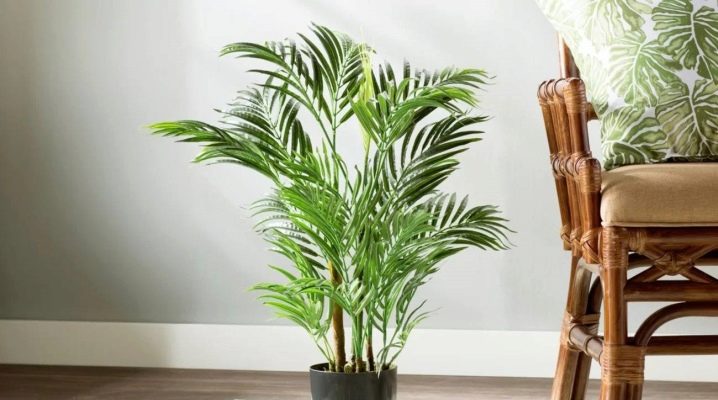
When arranging stylish modern interiors, indoor palm trees are often used. Chrysalidocarpus is considered one of the most popular varieties; this flower fits harmoniously into the design of any room. In our article, we will tell you how to properly care for this unusual plant so that it delights you with its decorative beauty for many years.
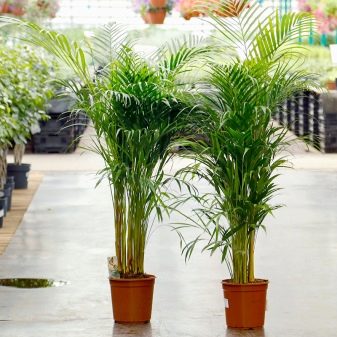
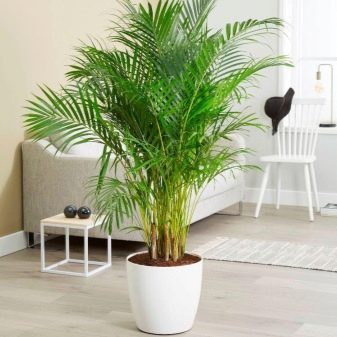
general description
The name of this home plant is far from always being pronounced the first time. However, despite its exoticism, chrysalidocarpus is a very patient and absolutely unpretentious plant. That is why it is so popular in interior design. Surely in the apartments of friends or in offices, you have repeatedly met this densely knotted bush with elongated leaves on freely spreading dry stems.
So what is this plant? Chrysalidocarpus belongs to plants from the arec family. In its natural environment, it is found in Madagascar and in some areas of the Comoros. In ancient Greek, its name means "golden fruit" - and in fact, its stems have a subtle yellowish tint. The second name, Areca, is considered obsolete today.
Chrysalidocarpus can have one or several trunks growing in the form of a bush. The stems, depending on the variety, can be smooth or slightly pubescent at the locations of the rings, lateral shoots extend from the trunks. The leaves are pinnate, lanceolate, arranged in 40-60 pairs. The color is deep green with small black dots.
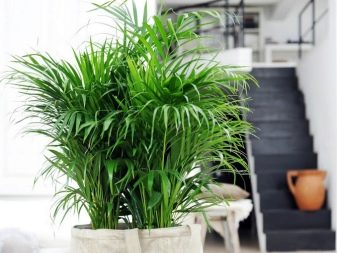
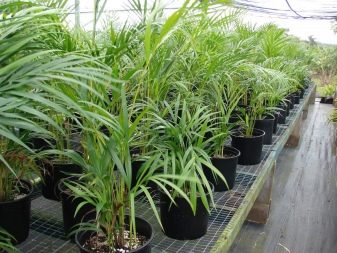
A palm tree can reach a height of 9 m.However, it is not worth counting on such a rapid growth - this plant adds no more than 15-20 cm per year.However, the owners of typical apartments only benefit from this, since in the absence of extra space, the palm tree will not deliver the slightest discomfort.
Providing chrysalidocarpus with comfortable conditions for growth and development is not difficult at all. In return, he will delight with his appearance. And, in addition, it will relieve households from excessive dryness of the air, thereby making the microclimate in the house healthier. In addition, it increases the humidity of the air, enriches it with oxygen, ozone and removes benzene and formaldehydes.
This is interesting: according to popular belief, this flower absorbs negative emotions and endows the home atmosphere with positive energy.
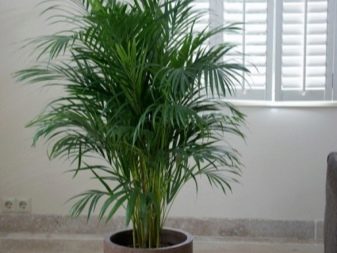
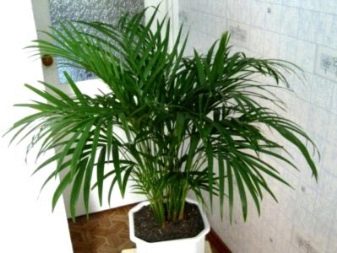
Popular types
In total, there are about two dozen species of chrysalidocarpus. However, only two varieties take root at home.
Lutescens
A characteristic feature of this palm is the absence of a trunk. The stems of the plant are very strong, closely fitting. The leaves are graceful, curved, feathery, have a pronounced yellow tint. Flowering of this palm tree occurs in late spring - early summer, medium-sized yellow flowers are combined into branched inflorescences. Later, the fruits appear, they also have a yellow color.
This plant can propagate both vegetatively by root suckers and by seed.
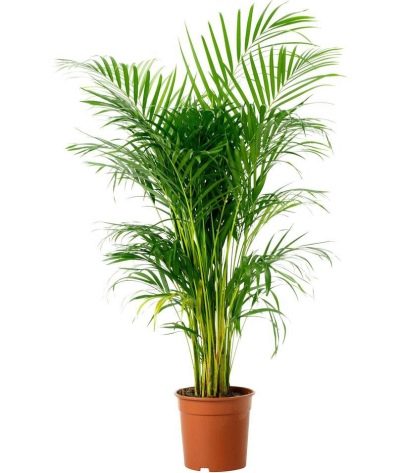
Madagascar
Unlike the previous variety, the Madagascar palm has a strong, smooth trunk with well-traced rings with a diameter of 20-25 cm. The leaves are pinnate, the surface is smooth, usually grow in bunches. The length of the sheet plate corresponds to 40-45 cm, the width is small - only 1.5-2 cm.
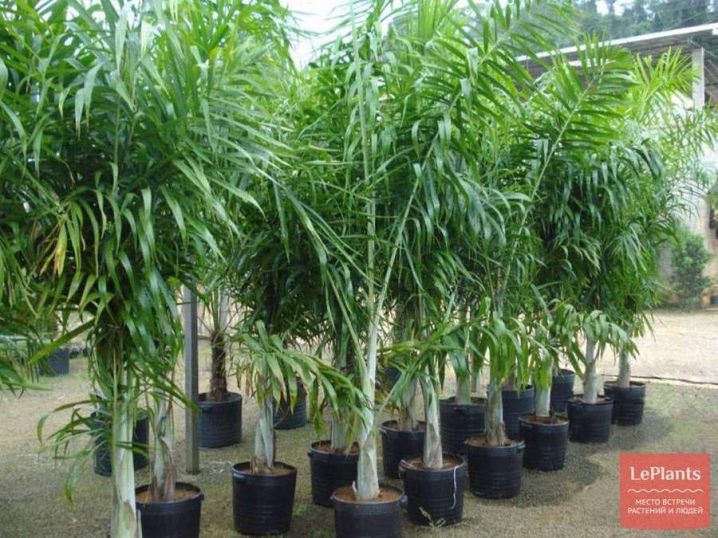
Transfer after purchase
Chrysalidocarpus should be transplanted after purchase. This is due to the fact that special components are added to store substrates that allow maintaining the presentation of the flower. However, with a long stay in such soils, the plant begins to feel an excess of nutrients and withers. A palm tree needs a transplant to adapt to new conditions of existence.
- Moving a houseplant from one container to another always becomes stressful for it and can cause negative reactions - loss of decorative appearance and leaf fall. Therefore, the transplant should be carried out by the transshipment method, trying to preserve the earthen lump as much as possible. The sequence of actions is simple.
- First you need to take a container of a larger size than the previous one and pour expanded clay, crushed stone or other drainage on the bottom.
- The plant is carefully removed from the pot, carefully examined and all damaged fragments are cut off.
- The palm tree, along with a lump of earth, is moved to a new site, the resulting voids are covered with new soil mixture and watered abundantly.
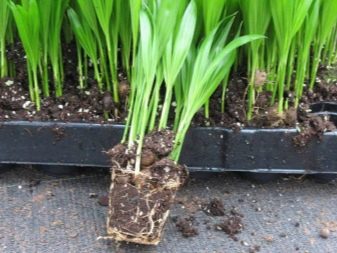
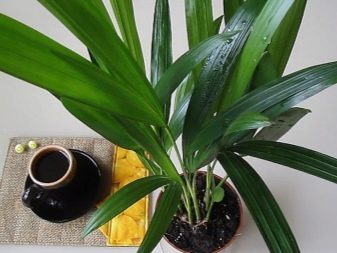
As a substrate, it is best to take a neutral or slightly acidic soil, always nutritious. In an alkaline environment, the palm tree will not assimilate beneficial trace elements, and the plant will stop growing and developing. A suitable substrate can be obtained from the store. Keep in mind that universal soil mixtures are unsuitable for such seedlings - they contain a significant proportion of peat, which impairs soil drainage. If desired, the composition is easy to prepare with your own hands. To do this, you need to mix 1 part of peat, river sand and wood ash and add 2 parts of clay-leaf and humus-leaf soil each, you can add a little perlite.
Important! Do not forget to disinfect and sterilize the prepared soil. Before transplanting, the earth must be held in the freezer for 24 hours, heated in a water bath or ignited in the oven.
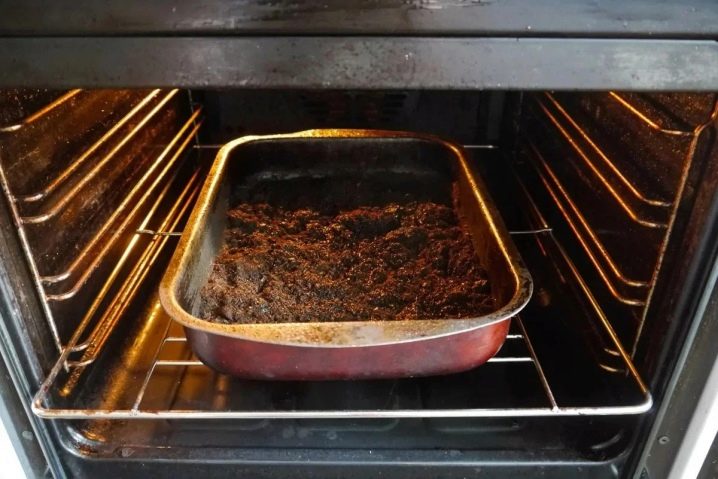
Care
Under natural conditions, the palm tree grows in the tropics, so it is naturally accustomed to the hot, scorching sun. This plant prefers well-lit places and high temperatures, however, excess heat and light can depress the palm tree. Young immature plants are especially affected - the leaves quickly turn yellow, curl and fall off one by one. But adult chrysalidocarpus, over 5-6 years old, are not afraid of any external factors - they become truly "impenetrable", they are able to withstand even a prolonged sun.
The optimal place for a palm tree will be a southern or southeastern window sill. During May - June, there is no need for additional shading. Starting in July, it is better to slightly cover the double-glazed windows with a paper screen or light tulle.
Tip: in order for the plant to have a more decorative appearance and the leaves are neatly distributed throughout the trunk, it is advisable from time to time to turn the container with the palm tree over with one or the other side to the light.
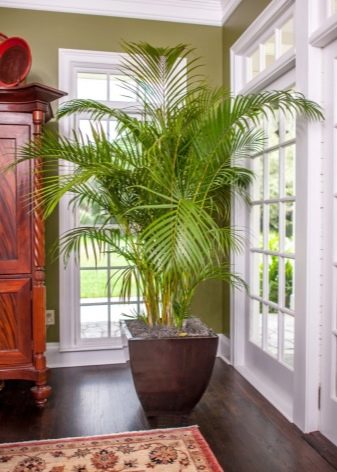
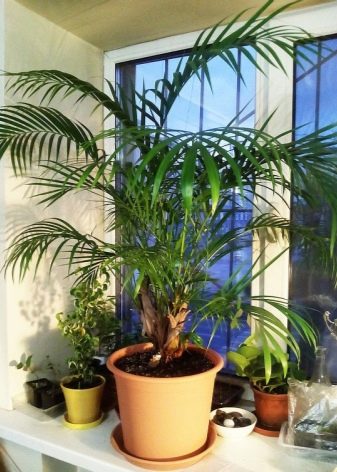
The comfortable temperature for chrysalidocarpus is 23-25 degrees throughout the year. In winter, a short-term decrease in temperature to +18 degrees is allowed, while temperatures below + 16 degrees cannot be allowed. The plant does not tolerate drafts, therefore, during airing, the palm tree must be carried away from the cold air.
Like any other exotic, indoor palm prefers humid air. In the summer, spraying should be done at least 2-3 times a week; in winter, it is enough to moisten the surface once a week. The presence of a humidifier will be a big advantage, especially during the period of operation of the heating system. If there is no such device in the house, it is advisable to place a bowl of water near the flower pot.Once a week, palm leaves are wiped with a damp soft cloth, this removes dust and the plants are able to consume more oxygen.
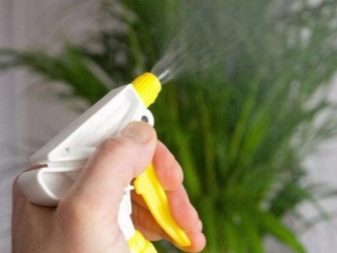

Watering is carried out as the earth dries up. It should be borne in mind that Areca plants are quite picky about the quality of watering - when using hard tap water, the palm tree may die, therefore it is necessary either to collect melt / rain water, or to specifically defend it. However, to save yourself the trouble, you can simply buy bottled water and add a pinch of citric acid to it.
Excessive watering should not be allowed. If root decay begins, then the flower will die in a short time. The first symptom indicating the development of pathological processes is a change in the color of the leaves - they darken. In this case, it is necessary to dig up the plant, remove the damaged areas of the roots and carefully loosen the substrate to allow it to dry out.
Chrysalidocarpus gratefully responds to feeding. It is suitable for specialized nutritional mixtures for palms or ornamental foliage plants.
In spring and summer, they are brought in every two weeks, with the onset of autumn and in winter - once a week. From March to September during the growing season, the palm requires additional foliar feeding.

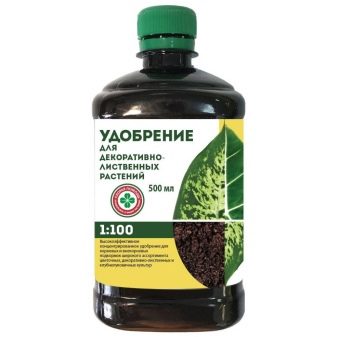
Reproduction methods
At home, the palm tree reproduces in late spring - early summer. Experienced flower growers noticed that during this period the seeds and shoots take root faster and actively grow. For reproduction, you can use both vegetative and seed methods.
Growing from seeds
The seed method of reproduction will require a lot of time from the owner of the chrysalidocarpus. Sometimes you have to wait several months for the first shoots to appear, which is why it is best to purchase seed from reliable sellers. To grow a new palm, the seedlings are soaked in a pale solution of potassium permanganate, processing is carried out for 2-3 hours. After that, the seeds are planted in cups filled with peat and covered with a film on top to create a mini greenhouse.
Until the emergence of shoots, the container should be kept in a warm, well-lit place, in which the temperature does not drop below + 23 degrees. The earth is regularly moistened, preventing it from drying out. In addition, every day for one to two hours, the shelter should be removed to ventilate the greenhouse.
As soon as the first shoots appear on the surface, each plant is moved to a separate pot.

Root processes
This is an easier method of propagation, since the root processes take root much faster and take root well. Young shoots are carefully separated from the parent plant with garden shears or a utility knife. At the roots, the tips are cut off and the shoots are placed in water for a couple of days, it is advisable to add a little "Kornevin" or any other growth stimulant to it. After that, the seedling is moved into pots with prepared soil mixture and sent to a shaded place, protected from direct sunlight.
Within a few weeks, the shoots take root, after which you can move them to the windowsill.
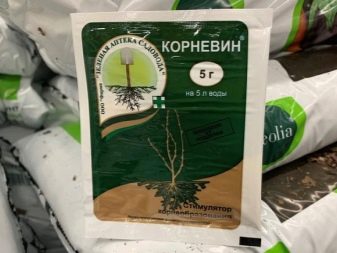
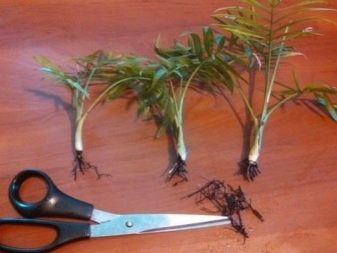
Diseases and pests
If the rules for caring for the plant are not followed, it begins to hurt.
- Leaves dry - this means that the palm tree has little water, both in the ground and in the air. In this case, you need to move the pot with chrysalidocarpus away from heating devices, increase the number of sprays and put a bowl of water next to it. If the above measures did not work and the leaves continue to dry out, the dosage of fertilizers with fluorine and superphosphate may have been exceeded.
- Brown spots - they talk about sudden changes in temperature or the use of cold hard water for irrigation. Chances are, your green pet's roots have already begun to rot.
- Rolling the leaves, the appearance of yellow-brown spots - indicate a sunburn.
- Small reddish oval spots are a sign of helminthosporiosis. When the first symptoms appear, spraying and watering should be stopped and treated with fungicides.
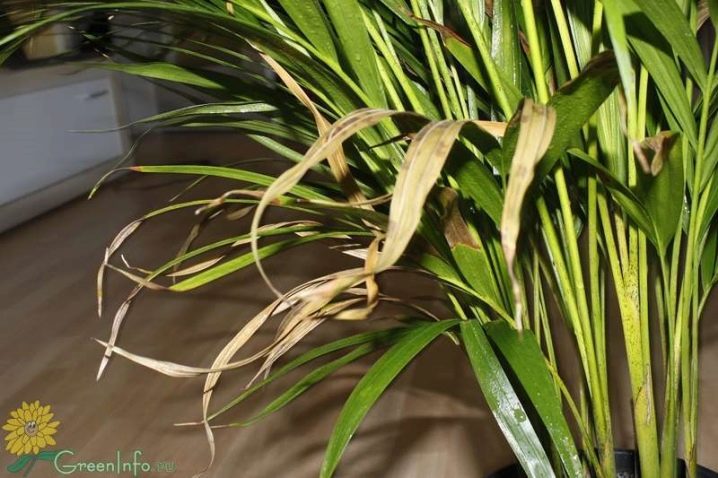
Of the insects, the most dangerous for chrysalidocarpus are those presented below.
- Thrips. The appearance of these pests is indicated by brown spots and small holes on the leaf blades. The development of a colony of these insects is facilitated by excessive dryness of the air and the lack of spraying. For treatment, treatment with the drugs "Aktellik", "Fitoverm" and "Aktara" is used.
- Spider mite. Just like thrips, mites appear in dry air. A sign of defeat is a whitish-silvery spider web on the leaves. It uses the acaricidal preparations "Appolo" and "Flumayt" against the pest; insecticides "Fitoverm" and "Actellik" give a good effect.
- Nematodes. The roots, stems and leaves of the plant are affected. It is impossible to cure such a bush; it is best to immediately dispose of the palm tree along with the container.
- Mealybug. The activity of this pest causes the wilting of the flower, a delay in its growth and development. To prevent its appearance, it is necessary to strictly observe the mode of moistening and watering, as well as regularly remove all dried leaves. To kill insects, they are sprayed with infusions of garlic or tobacco, a solution of green soap, as well as with preparations "Aktara", "Calypso", "Confidor" and "Fitoverm".
- Shield. Brown spots on the leaves indicate the appearance of this pest. For treatment, wiping the leaves with a soap-alcohol solution is used; for its preparation, 15 g of liquid soap and 10 ml of alcohol are dissolved in a liter of water. Ready-made preparations "Actellik", "Fosbecid" and "Aktara" give a good effect.
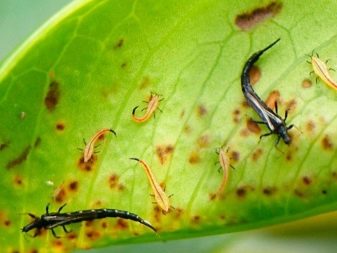
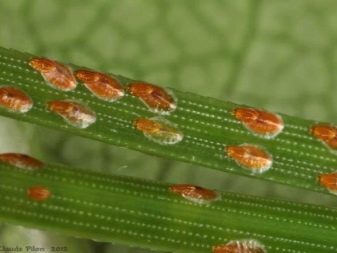
The plant also suffers from a lack of nutrients. So, the appearance of yellow and orange spots with the simultaneous twisting of the leaf plates indicates a potassium deficiency. With a lack of magnesium, light stripes appear on the leaves, pronounced chlorosis indicates a deficiency of manganese. And if the leaves are covered with multiple necrotic spots, then the plant needs a portion of zinc.
In general, disease is easier to prevent than to cure. Compliance with basic preventive measures significantly reduces the risk of pests and pathogens of fungal infections on green pets.
Regularly inspect the plant, observe a comfortable mode of lighting, watering and feeding, replant the palm tree every 2-3 years in fresh soil and avoid crowding. Only in this case will chrysalidocarpus delight you with its healthy appearance for many years.
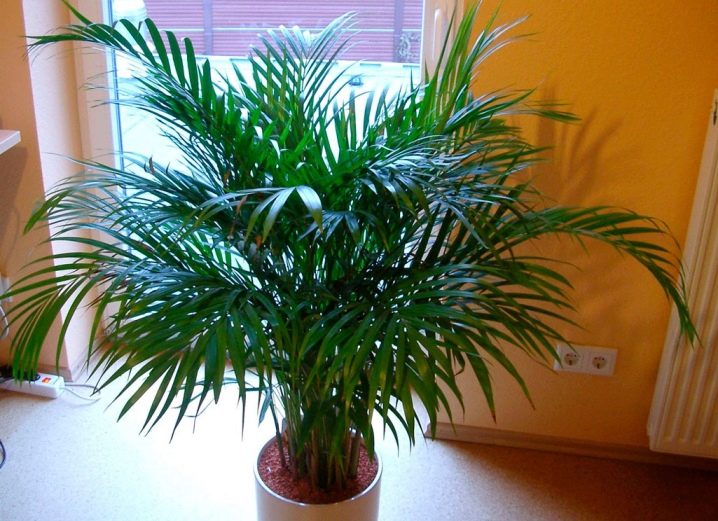































The comment was sent successfully.